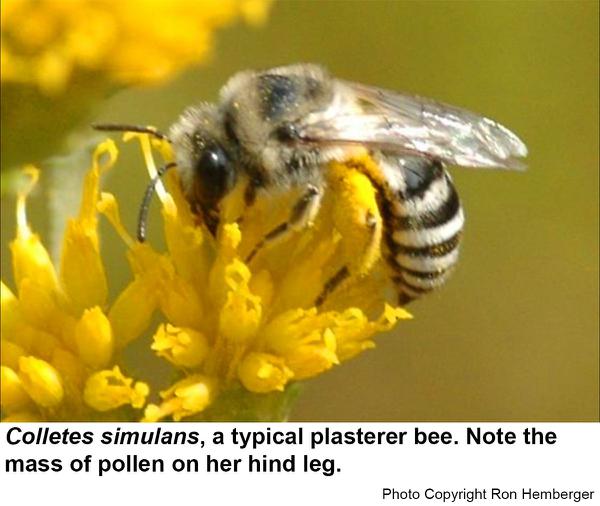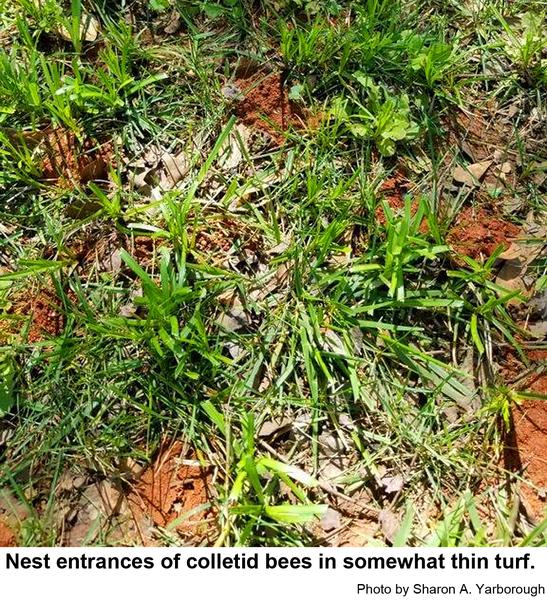Description and Biology
Colletid bees are short-tongued, primitive bees in the family Colletidae. They are sometimes called plasterer bees, cellophane bees, or polyester bees because the females plaster or line their brood cells with a cellophane-like substance that is actually one of the polyesters! These bees are black with pale setae around the thorax and setae forming pale bands on the abdomen. They are about the size of a honey bee (but their eyes are bare—honey bees have short hairs on the eyes). Colletid bees have one generation per year. The bees emerge each spring. Each female excavates her own nest without help of other bees. Usually at a location that gets morning sun, a female selects a spot on soil that is well-drained and often sandy with little organic matter. As she digs, she throws the excavated soil out of the tunnel where it collects around the nest opening. She then excavates a small cell and using her mouthparts, coats the interior of the cell with polyester presumably secreted by her salivary glands. The female then collects pollen and nectar and forms a mass on top of which she lays a single egg. The cell is then closed and the female continues to excavate and provision other cells. A tiny, white grub hatches sometime afterward and consumes the pollen mass. The grub molts several times as it grows and finally becomes a prepupa which then molts into a pupa and finally into a new adult bee that emerges from the soil the following spring. Once the spring flight of colletid bees dies out, no observable activity occurs in the area until the following spring.
Host Plants
Colletid bees use pollen and nectar as the predominant food source for their grubs. They visit just about any flowers available, especially those of the aster family.
Residential Recommendations
Control of colletid bees is often contemplated because they are perceived to be an annoyance or danger. These bees have no "nest guarding instinct" as do the social wasps and social bees. Just walking by the nests will not prompt the bees to "attack" as they do not have alarm pheromones and instinctive behavior to "know" how to attack. It may be possible to step on a colletid while barefooted and get stung on the foot, but that is about the only hazard from these otherwise beneficial insects. Colletid bees are valuable pollinators of spring crops. It is better to coexist with the bees because of their value in the pollination of various crops than try to eradicate them with pesticides.
References
- Ground-Nesting Bees in Turf. Billeisen, T. et al. 2017. TurfFiles, NC State Extension Publications
- Guide to Wild Bees. Sharp, P. and R. Eatman 2017. New York's Rockefeller State Park Preserve and neighboring Stone Barns Center for Food and Agriculture.
- Invite Cellophane Bees to Your Garden by Providing Patches of Bare Soil. Holm, H. 2015. Gardening Guides|Beneficial Insects, Houzz.com.
- Phylogeny of colletid bees (Hymenoptera: Colletidae) inferred from four nuclear genes. Almeida, E. A. B. and B. N. Danforth. 2009. Molecular Phylogenetics and Evolution 50 (2009) 290–309.
- Pollen hosts of western palaearctic bees of the genus Colletes (Hymenoptera: Colletidae): the Asteraceae paradox. Müller, A. and M. Kuhlmann. 2008. Biological Journal of the Linnean Society 95: 719–733.
- Extension Plant Pathology Publications and Factsheets
- Horticultural Science Publications
For assistance with a specific problem, contact your local N.C. Cooperative Extension Center.
This Factsheet has not been peer reviewed.
Publication date: May 6, 2017
Reviewed/Revised: Feb. 16, 2022
N.C. Cooperative Extension prohibits discrimination and harassment regardless of age, color, disability, family and marital status, gender identity, national origin, political beliefs, race, religion, sex (including pregnancy), sexual orientation and veteran status.



